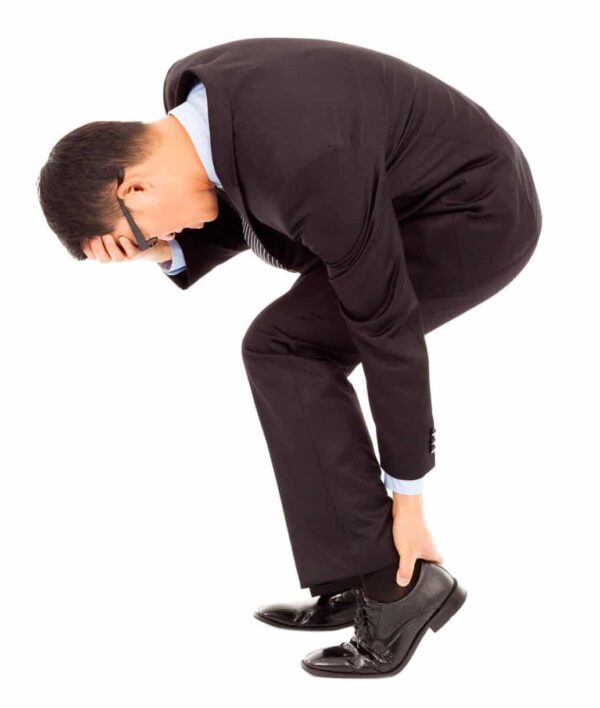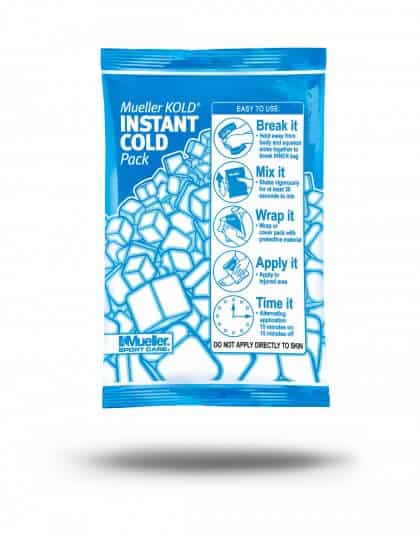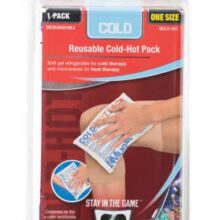Cold & Hot Reusable Compress
In Stock
The DynaPro Reusable Hot/Cold Pack is a versatile non-toxic compress that you can use for both hot and cold therapies and for treatment of both acute and chronic injuries.

Pain behind the ankle is experienced by many people at one time or another. Most of the time, it can be attributed to one of three possible conditions. These are achilles tendonitis, bursitis of the ankle and ankle arthritis – the most common causes of ankle pain besides ankle sprains.
In this article, we will briefly discuss the other symptoms (besides pain behind the ankle) presented by each of these conditions. This will give the reader some tools by which he may be able to identify the cause of posterior ankle pain. We also provide some advice on the course of action if each of these conditions is suspected.
An individual suffering from pain behind the foot and ankle should consult a doctor for medical advice. The doctor will be able to provide an official diagnosis and a suggested treatment plan. The information provided in this article is for general guidance only.
This is caused by an overuse injury to the Achilles tendon. It is most commonly seen in people who participate in physical activities like running and jumping.
In general, this condition causes pain and swelling over the achilles tendon. This is the large tendon that connects the heel bone to the calf muscles. It runs along the back of the leg.
Achilles tendinitis pain typically starts as a mild ache in the achilles tendon. It will tend to flare up just after completion of activities such as a tennis or basketball game.
If the pain behind the heel is as described above, see a doctor for medical advice, diagnosis and a treatment plan. Left untreated this medical condition can worsen and eventually culminate in achilles tendon rupture.
If the diagnosis confirms the presence of this condition, a period of rest (suspension of physical exercise) is a good idea. The condition should start to show some improvement after a few days.
In addition, the doctor may recommend pain relief medication such as Tylenol (paracetamol) or Advil (ibuprofen) while the condition improves.
Physical therapy exercises to stretch and strengthen the Achilles tendon and connecting calf muscles will be of benefit. It will help to avoid recurrence of the condition once normal activities are resumed.
There may be no improvement with gentle stretching exercises. If so, then more specific so-called eccentric heel-drop exercises (first described by Alfredson) should be the next step. Surgery is sometimes used as a last resort when there has been no response to other measures.
This condition causes pain behind the ankle due to the presence of bursae in that area. These fluid filled sacs can become irritated and then inflamed if they are subject to trauma or persistent stress over time.
The retrocalcaneal bursa is located at the back of the heel. Inflammation of this bursa will typically lead to pain, redness and swelling behind the ankle. These will be experienced between the heel bone and the Achilles tendon.
In addition to pain above and behind the ankle, the patient may experience swelling at the top of the heel bone. The pain may also increase if the back of the heel is touched or if the foot is flexed or extended.
Once again, the affected individual should consult a physician for diagnosis and treatment.
If ankle bursitis is the cause of the pain, the best solution is to rest by refraining from physically demanding activity. This will allow the bursae to recover naturally. An ice pack will provide additional pain relief and swelling reduction. Anti inflammatory medication like advil (ibuprofen) will help to fight both the pain and inflammation.
Once again, physical therapy exercises will be an important part of the treatment. They will help the individual return to normal activity with less risk of reinjury.
Decreasing pressure to the affected area by wearing shoes with plenty of cushioning will ease pressure on the bursar. Other measures to reduce friction will also ease the pressure on the bursae and promote healing.
Shoe inserts can also be helpful. Corticosteroid injections are sometimes tried when conservative measures fail.
The ankle joint is less commonly affected by osteoarthritis than the hips, knees, fingers, thumbs and lower spine.
However, ankle arthritis will cause long lasting and continual pain, stiffness and restricted movement of the ankle joint. Additionally, those affected may feel a grinding sensation at the back of the ankle above the heel.
The most common types of arthritis are rheumatoid arthritis and osteoarthritis. Gout is another type of arthritis that commonly attacks the foot. However, its pain is usually located just behind the big toe and it only occasionally affects the ankle. It is the result of an accumulation of uric acid in the blood..
Unlike achilles tendonitis or ankle bursitis, ankle arthritis will tend to be most painful upon awakening in the morning. It will also result in the greatest ankle stiffness at these times. This pain and stiffness tend to improve within about half an hour or so of starting to use the ankle.
As with the other conditions, the first thing to do is to visit a doctor for a diagnosis and medical advice.
If the doctor confirms the presence of arthritis, the treatment plan will depend on the type of arthritis. For rheumatoid arthritis, there is an array of drugs doctors can prescribe to slow its development. If osteoarthritis is the cause of the pain, doctors may suggest pain relief medication combined with physical therapy and activity modification.
Weight loss can reduce the burden on affected joints. Additionally, specific exercises can strengthen the muscles around affected joints and help to maintain a good range of movement.
Joint replacement can be considered for some older patients in whom conservative measures have not improved their symptoms enough.

In Stock
The DynaPro Reusable Hot/Cold Pack is a versatile non-toxic compress that you can use for both hot and cold therapies and for treatment of both acute and chronic injuries.


Typically Ships in 1-2 weeks
The Mueller Sports Medicine MuellerKold Instant Cold Pack is ready for use whenever you need it. It needs no refrigeration and activates instantly. This fast-acting cold compress is ideal for acute sports injuries or other situations requiring first aid.


Typically Ships in 1-2 weeks
The soft gel of the Mueller Sports Medicine Reusable Cold/Hot Pack refrigerates for cold therapy and microwaves for heat therapy. Recommended for treatment of both acute and chronic injuries as well as minor muscle aches and pains.